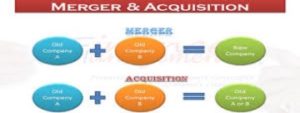Horizontal Merger Definition
In this article we discuss horizontal mergers with examples. These are commonplace in the M&A space and take place when two (or more) competing firms offering similar product lines or services combine to form an enlarged entity. It is not necessary that the firms be in the same geographic area.
These mergers are more common in industries with fewer competitors. Since competition among fewer companies tends to be higher, the goal is to create a larger business with greater market share and economies of scale and exploit the synergies. Because of the size and scale of some of these mergers, it is sometime difficult to discern whether the combination is a merger or acquisition. To address this issue we have a separate article entitled The Differences Between Mergers and Acquisitions – Examples & Explanations to assist our readers. This article forms parts of a series of articles on types of merger and acquisitions. For more information on vertical mergers or conglomerates, please visit our mergers and acquisitions category page.

How Horizontal Mergers Create Value
The primary reason for the horizontal combination is to reduce costs. This puts the focus looking backward towards suppliers in the value chain. The combination of the firms increases the buying power of the combined entity and puts pressure on the supplier to lower the cost of the inputs supplied to the combined firm. Profits can be increased by reducing input costs whilst maintaining sales levels and prices. Many firms favor this type of amalgamation as it keeps the focus away from the consumer thus reducing the chances of regulatory interference. Michael E. Porter refers to this as one of his 5 forces in his book Competitive Strategy as the Bargaining power of customers.
However, this is not the only potential benefit to the merger. The firm may wish to draw the wrath of the appropriate regulatory authorities by charging higher prices to its customers. This is done under the guise of product improvements or increased service levels. With less competition following the merger, companies are often keen to maximize their new industry position.
Additional sources of income of ways of raising profitability can be made by eliminating overlap especially in research & development budgets whilst maintaining output. Mid-tier management is also often at risk as job duplication can also be eliminated to help cut costs. This is especially true if the combining firms are in the same geographic area.
If there is no overlap in this instance, this expansion into new territories can be maximized by the increase in the product range. Manufacturing capability or product development can also be improved as the combined technologies help create superior products. These can be sold at higher prices or used as a way to consolidate market share.
Advantages and Disadvantages of Horizontal Mergers at a Glance
Advantages
Larger Market Share
Bigger Base of Customers
Increased Revenue
Creating economies of scale
Disadvantages
Regulatory Scrutiny
Stunting economic growth
Reduced flexibility
Destroying value
Horizontal Merger Guidelines
The Merger guidelines in the United States are a set of rules formulated by the Antitrust Division of the Department of Justice (DOJ) and the Federal Trade Commission (FTC).
These rules oversee the process by which these two regulatory bodies scrutinize and potentially challenge a potential merger. Grounds for challenges include increased market concentration and threat to competition within a relevant market as noted in the above sections.
Detailing and explaining these rules is beyond the scope of this article so for a complete analysis we direct the reader to the original source, the DoJ website. Alternatively, readers may download a copy of the guidelines in PDF format.
Horizontal Mergers with Examples
- Anheuser-Busch InBev (BUD) is an example of how mergers work and unite companies together. The company is the result of numerous mergers, consolidation, and market extensions in the alcoholic beverages market. The newly named company, AB InBev, is the result of the mergers of four large international beverage companies
- Interbrew (Belgium)
- Ambev (Brazil)
- Anheuser-Busch (United States)
- SAB Miller (South Africa)
Ambev merged with Interbrew uniting the number three and five largest brewers in the world. When Ambev and Anheuser-Busch merged, it united the number one and two largest brewers in the world. This represents both a horizontal merger example as it was industry consolidation and a market extension example because it also extended the international reach of the combined company’s product portfolio.
- Anheuser-Busch InBev (BUD) is an example of how mergers work and unite companies together. The company is the result of numerous mergers, consolidation, and market extensions in the alcoholic beverages market. The newly named company, AB InBev, is the result of the mergers of four large international beverage companies
- A famous and significant domestic horizontal merger was the combination of Exxon and Mobil in 1998 to form the Exxon Mobil Corporation (XOM). At the time, this was the largest example of a merger in all of history and was valued at $78.9bn. The newly formed company was the third largest in existence.
- The 1998 merger of Daimler-Benz and Chrysler is considered a horizontal merger.
- Another famous example of a horizontal merger, but not one that was considered a great success, was between HP (Hewlett-Packard) and Compaq in 2011 (HPQ). The merger between these two companies created a global technology behemoth initially valued at approximately $87bn. HP subsequently became the subject of a hostile merger approach from Xerox (XRX).
Key Takeaways
- A horizontal merger is when two or more companies in the same industry merge into a single entity.
- Has the potential to significantly increase revenues and profits through sales of products and services from the combined range of offerings.
- Often result in a reduction of competition and the simultaneous creation of a more powerful rival to existing firms.
Finding this information useful? Here's what you can do to help...
- Share this page using the toolbar links at the left of your screen or at the bottom for mobile users on your preferred social network
- Sina Weibo
- Twitter etc.
- Follow us on twitter @MergeArbLimited.
- Become friends with us on Facebook
- Register for news alerts and merger arbitrage deal analysis postings via email using the sign up form.
- In addition to these, an RSS feed is also available at the bottom right of the page.
- Contact us using the details given on the Contact Us page.
- Donate using the paypal widget in the sidebar. It’s gladly appreciated and we need the coffee! See the Paypal section for additional incentives
- Share this page using the toolbar links at the left of your screen or at the bottom for mobile users on your preferred social network
Thanks for reading!







